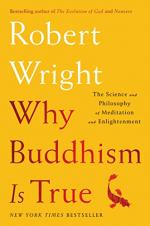
|
| Name: _________________________ | Period: ___________________ |
This test consists of 15 multiple choice questions and 5 short answer questions.
Multiple Choice Questions
1. What is the meaning of the term metta?
(a) Loving kindness.
(b) Extraordinary.
(c) Mantra.
(d) Saturation.
2. The author states that "coherence of motivation, though a desirable quality in a friend or collaborator, isn't by itself" (82) what?
(a) Satisfying.
(b) Decisive.
(c) Effective.
(d) True.
3. What is the title of Chapter 3 of Buddhism is True?
(a) Nirvana in a Nutshell.
(b) Like, Wow, Everything is One.
(c) When Are Feelings Illusions.
(d) Your CEO is MIA.
4. What adverb is used to describe briefly exposing someone to a word or an image, but not long enough for conscious awareness to set in?
(a) Undertemporally.
(b) Multilingually.
(c) Subliminally.
(d) Subdermally.
5. When scientists conducted an experiment asking people to choose one of four identical pairs of pantyhose, which one did they most often choose?
(a) The second from far right pair.
(b) The far right pair.
(c) The far left pair.
(d) The second from far left pair.
6. What does the author NOT list among the most popular reasons for people to try meditation?
(a) To quell self-loathing.
(b) To cool anger.
(c) To make better decisions.
(d) To relieve stress.
7. Western Buddhism eliminates all but which of the following traditional Buddhist traditions?
(a) The use of gongs.
(b) Meditation on the pus within one's own body.
(c) Meditation on one's own rotting corpse.
(d) Meditation on feces within one's body.
8. What disorder does the author say makes it difficult for him to meditate?
(a) Clinical depression.
(b) Autism.
(c) Asperger's syndrome.
(d) Attention deficit disorder.
9. Which character in the movie referred to in the chapter entitled "Take the Red Pill" realizes that his life has actually been an extended hallucination?
(a) Morpheus.
(b) Hagar.
(c) Neo.
(d) Altoo.
10. To what movie does the first chapter, entitled "Taking the Red Pill," refer?
(a) The Matrix.
(b) Drugstore Cowboy.
(c) Taxi Driver.
(d) Magnolia.
11. What is the name of the eminent twentieth-century scholar of Buddhism?
(a) Bhikkhu Bodhi.
(b) Edward Conze.
(c) Jerome Barkow.
(d) Aaron Beck.
12. What is NOT one of the five aggregates named by The Buddha when he first split the self into five aggregates?
(a) Longings.
(b) Feelings.
(c) The physical body.
(d) Mental formations.
13. What is the one thing that the author says natural selection "cares about" (3)?
(a) Survival.
(b) Sustenance.
(c) Procreation.
(d) Evolution.
14. The Buddha stated that what emotion has a "poisoned root and honeyed tip" (30)?
(a) Anger.
(b) Ecstasy.
(c) Jealousy.
(d) Pride.
15. Whom does the author name as being on the lowest end of the spectrum in relation to how easy it will be for a person to pick up meditation?
(a) John McEnroe.
(b) Nate Diaz.
(c) Bobby Knight.
(d) Russell Westbrook.
Short Answer Questions
1. The word vipassana is generally translated to what English word?
2. What do psychologists call the network in the brain that is active when people are not doing anything in particular?
3. According to Buddhist scripture, what is the name of the braggart who challenged The Buddha's notions of not-self?
4. On what body process should first-timers focus when meditating?
5. In most people, the left hemisphere of the brain controls what?
|
This section contains 491 words (approx. 2 pages at 300 words per page) |

|




